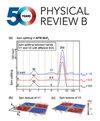Enhanced quantum sensitivity and coherence of symmetric magnetic clusters
IF 3.7
2区 物理与天体物理
Q1 Physics and Astronomy
引用次数: 0
Abstract
Searching for highly coherent degrees of freedom in noisy solid-state environments is a major challenge in condensed matter. In disordered dipolar systems, such as magnetically doped insulators, compact clusters of two-level systems (TLS) have recently been shown to have significantly longer coherence times than typical single TLS. Coupling weakly to their environment, they sense and probe its many-body dynamics through the induced dephasing. However, it has remained an open question whether further mechanisms exist that protect the coherence of such solid-state qubits. Here, we show that symmetric clusters of a few TLS couple even more weakly to their surroundings, making them highly sensitive quantum sensors of slow many-body dynamics. Furthermore, we explore their use as qubits for quantum information storage, detailing the techniques required for their preparation and manipulation. Our findings elucidate the role of symmetry in enhancing quantum coherence in disordered and noisy systems, opening a route toward a sensitive experimental probe of many-body quasilocalization dynamics as well as the development of quantum technologies in solid-state systems.增强对称磁簇的量子灵敏度和相干性
在嘈杂的固态环境中寻找高度相干的自由度是凝聚态的一大挑战。最近的研究表明,在无序双极性系统(如磁掺杂绝缘体)中,紧凑的两级系统(TLS)簇具有明显长于典型单TLS的相干时间。它们与周围环境的耦合很弱,可以通过诱导的去相位来感知和探测周围环境的多体动力学。然而,是否存在保护这种固态量子比特相干性的进一步机制,仍然是一个未决问题。在这里,我们展示了由几个 TLS 组成的对称簇与周围环境的耦合更加微弱,从而使它们成为对慢速多体动力学高度敏感的量子传感器。此外,我们还探讨了它们作为量子信息存储的量子比特的用途,并详细介绍了制备和操纵它们所需的技术。我们的发现阐明了对称性在无序和嘈杂系统中增强量子相干性的作用,为多体准定位动力学的灵敏实验探测以及固态系统中量子技术的发展开辟了一条道路。 美国物理学会出版 2025
本文章由计算机程序翻译,如有差异,请以英文原文为准。
求助全文
约1分钟内获得全文
求助全文
来源期刊

Physical Review B
物理-物理:凝聚态物理
CiteScore
6.70
自引率
32.40%
发文量
0
审稿时长
3.0 months
期刊介绍:
Physical Review B (PRB) is the world’s largest dedicated physics journal, publishing approximately 100 new, high-quality papers each week. The most highly cited journal in condensed matter physics, PRB provides outstanding depth and breadth of coverage, combined with unrivaled context and background for ongoing research by scientists worldwide.
PRB covers the full range of condensed matter, materials physics, and related subfields, including:
-Structure and phase transitions
-Ferroelectrics and multiferroics
-Disordered systems and alloys
-Magnetism
-Superconductivity
-Electronic structure, photonics, and metamaterials
-Semiconductors and mesoscopic systems
-Surfaces, nanoscience, and two-dimensional materials
-Topological states of matter
 求助内容:
求助内容: 应助结果提醒方式:
应助结果提醒方式:


